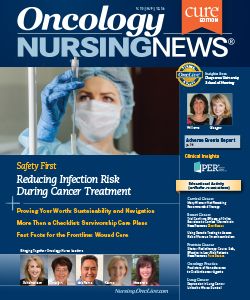Early Sepsis Recognition in Outpatient Settings: Challenges and Progress
Nurses should be aware of how to identify sepsis in patients with cancer to facilitate early diagnosis and immediately treatment.
Laura Messineo, RN, MHA

Laura Messineo, RN, MHA
Many cases of sepsis are discovered in inpatient settings as comorbidities occurring with other, more prominent medical issues. Frequently diagnosed in ICU settings, sepsis has usually progressed past its early stages once identified. Patients with cancer are at particularly high risk for developing sepsis, and severe septic infections are a factor in at least 8.5% of all cancer-related deaths.1
Sepsis risk in the oncology setting is due to a variety of factors. Frequent hospital stays, surgeries, catheter insertions, and other procedures all increase the risk. These patients also already have depressed immune systems and are likely malnourished and frail as a result of treatments and therapies.2
It is vitally important that sepsis be diagnosed as early as possible to ensure immediate, appropriate treatment. However, sepsis is usually diagnosed only after patients arrive at hospitals, when critical treatment windows might have already passed.3
With so many patients arriving to inpatient facilities with severe sepsis, there is clearly a need for protocols and procedures to help with identification of sepsis in ambulatory facilities, where nurses are on the frontlines of healthcare and in a prime position to recognize sepsis and refer patients for immediate treatment.
Barriers to Early Sepsis Recognition
According to the Sepsis Alliance, more than 1.6 million Americans, including many patients with cancer, are diagnosed with sepsis every year,4 but significant obstacles to early sepsis recognition remain after these patients are discharged from acute care facilities.
Septic infections begin outside of the hospital for nearly 80% of patients,5 but the public is generally unfamiliar with sepsis as a medical condition; in fact, only 55% of American adults have even heard of it.4 Lack of community awareness presents a huge hurdle to effective sepsis management and can have severe implications for patients with cancer when they return home. Patients and families might receive sepsis education before discharge, but there is no guarantee that the information, if provided, will be effective in illustrating the necessity of sepsis monitoring and the need for urgent treatment if symptoms develop.
Healthcare provider familiarity with sepsis is also an issue, suggesting a need to educate nurses, physicians, and emergency medical technicians on the signs and symptoms of early sepsis. Sepsis, by its very nature, looks like many other diseases. Since many of the early signs of sepsis could apply to a variety of other conditions or diseases, it is especially hard to diagnose.
Sepsis screening tools and bundles have been around for about a decade,6 but these are not commonly utilized in outpatient settings. Nurses might not even know what symptoms of early sepsis to look for in patients with cancer.
As Laura Messineo, RN, MHA, and Sepsis Alliance Board Member explained, “There is a lack of screening in the [outpatient] environment. How many patients come in that have some source of infection, and are [providers] really looking for any kind of systemic inflammatory response out of these patients? I think the core problem is that we aren’t screening for it.”
“Nurses don’t necessarily come out of school with a comprehensive understanding of sepsis,” she continued, “and that really leaves it on the employer, whether in the acute care setting, the outpatient setting, or skilled nursing facilities. I do believe there’s a need for ongoing education in whatever setting nurses practice in.”
Learn More
The Sepsis Alliance (www.sepsisalliance.org) has valuable resources for patients and healthcare practitioners, including handouts and patient education counseling points, along with a special “Nurses Know Sepsis” series, featuring first-person nurse-focused case examples describing their clinical experiences with sepsis.
Inpatient Screening Tools as a Model
Seven in 10 patients with sepsis have recently used healthcare services or have chronic conditions requiring frequent medical care,5 and nurses in oncology outpatient settings are in a unique position to educate and screen patients for signs of sepsis.
Current efforts in inpatient settings to develop sepsis screening tools could be applied in the outpatient setting. Several healthcare facilities across the nation, including the University of San Francisco Medical Center, Banner Health, and Presence Health, are developing sepsis screening tools that continually evaluate patient data as it is populated into electronic health records, flagging those patients most at risk for developing sepsis for more careful monitoring.6-9
“There is great opportunity to transfer this type of screening process to the outpatient setting. If you really think about the outpatient setting, the question of, ‘Does the patient have infection, or is there suspected infection?’ becomes important,” said Messineo.
“If we could hardwire sepsis screening into outpatient settings, I think we could catch more patients that are heading toward severe sepsis, and get them the right treatment, so they don’t escalate to septic shock and acute care treatment. There should be actionable steps taken by clinicians for those patients who are identified,” she continued.
Bigger organizations are also working to expand the healthcare provider knowledge base regarding sepsis. The Sepsis Alliance is currently “working on lots of different educational tools for all settings that have recorded dialogue so you wouldn’t actually need a physical person coming out there to provide education. The same message would get to every clinician.”
Resources are geared toward clinicians and patients to aid in the identification of early sepsis. Additional efforts to increase public and provider awareness of sepsis and its early signs continue in the community outside of healthcare facilities.
“I started seeing, on social media alone, patients saying ‘I never knew what [sepsis] was. If I knew the signs, I would have come in for treatment,’” said Messineo. “That really started a movement to increase awareness through special community events. One is a 5K that is solely focused on bringing healthcare clinicians and our community together to recognize those early sepsis warning signs.”
Because so many patients die from septic infections, it is more crucial than ever for healthcare providers, patients, and their caregivers to receive education so they can recognize the early signs—especially outside of acute care facilities. Nurses are in a unique position to educate patients with cancer and their families, but they have to have adequate knowledge of sepsis personally before meaningful education can occur.
“These patients should be armed with this information. Many times, oncology patients die of sepsis and not the actual cancer. We know that sepsis is the third leading cause of death in the United States, so there should be just as much focus on sepsis as there is on heart disease or stroke,” Messineo concluded.
References
- Williams MD, Braun LA, Cooper LM, et al. Hospitalized cancer patients with severe sepsis: analysis of incidence, mortality, and associated costs of care. Crit Care. 2004;8(5):R291-R298.
- Sepsis Alliance. Sepsis and Cancer. http://bit.ly/2gek3Jg. Accessed November 21, 2016.
- Seymour CW, Rea TD, Kahn JM, et al. Severe sepsis in pre-hospital emergency care. Am J Respir Crit Care Med. 2012;186(12):1264-1271.
- Sepsis Alliance. Sepsis Fact Sheet. http://bit.ly/2gDmQPE. Accessed November 21, 2016.
- CDC Vital Signs. Making Health Care Safer. Think sepsis. Time matters. http://bit.ly/2c3yFuW. Accessed November 21, 2016.
- ECRI Institute. Sepsis: Combating the Hidden Colossus. http://bit.ly/2garsYj. Accessed November 21, 2016.
- Khurana HS, Groves RH Jr, Simons MP, et al. Real-time automated sampling of electronic medical records predicts hospital mortality. Am J Med. 2016;129(7):688-698.
- Sidney Kimmel Comprehensive Cancer Center at Johns Hopkins Hospital, Johns Hopkins School of Nursing. Oncology Interdisciplinary Early Goal-Directed Sepsis Management Protocol for IPOP & HIPOP Clinic. http://bit.ly/2gDql8I. Accessed November 21, 2016.
- Schell-Chaple H, Lee M. Reducing sepsis deaths: A systems approach to early detection and management. American Nurse Today. 2014; 9(7): http://bit.ly/2fWjUsU. Accessed November 21, 2016.




